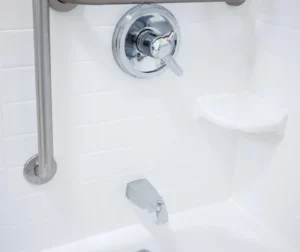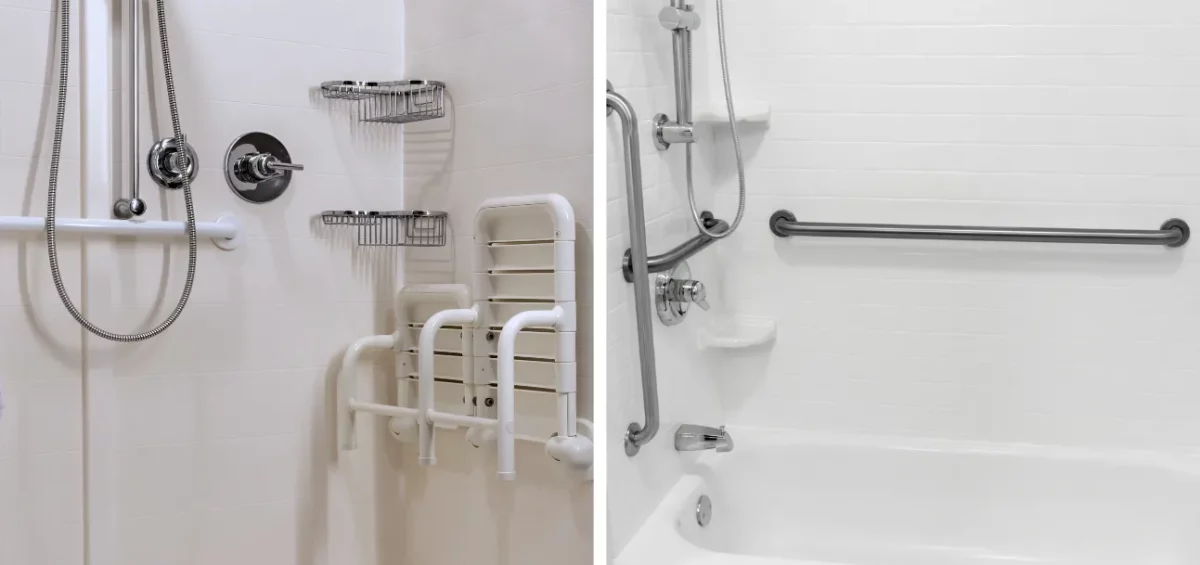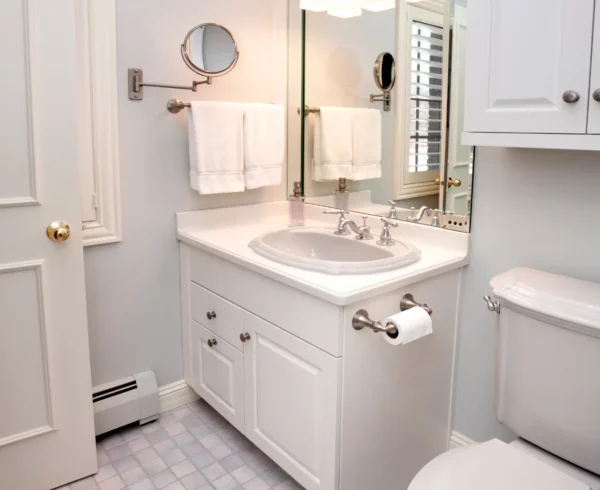Choosing between accessible bathtubs and showers can be tricky, especially if you or a loved one has mobility challenges. Each option has its features and benefits, making the bathing experience safer and more comfortable. But it’s important to know that both have downsides and what works great for one person might not be the best fit for another.
In this article, we will compare the two. This way, you can figure out which fits your or your loved one’s needs best. Whether you’re dealing with mobility issues now or planning for the future, this comparison will help you understand what to expect from these bathroom options.
Accessible Bathtubs Vs. Accessible Showers
When choosing between accessible bathtubs vs. accessible showers, it’s essential to consider your own needs and preferences, as what works for one person may not be the best choice for another.
Features and Benefits of Accessible Bathtubs
 Accessible bathtubs or walk-in tubs represent a significant advancement in bathroom design, especially for individuals with mobility challenges. The standout feature of these tubs is their watertight door, which allows for much easier and safer entry. This door, combined with an ultra-low step-in threshold, allows those with limited mobility to transfer into the tub with greater ease. Once inside, a built-in seat provides a comfortable and secure place to enjoy a bath without the need to lower oneself to the tub floor.
Accessible bathtubs or walk-in tubs represent a significant advancement in bathroom design, especially for individuals with mobility challenges. The standout feature of these tubs is their watertight door, which allows for much easier and safer entry. This door, combined with an ultra-low step-in threshold, allows those with limited mobility to transfer into the tub with greater ease. Once inside, a built-in seat provides a comfortable and secure place to enjoy a bath without the need to lower oneself to the tub floor.
One of the biggest perks of these type of bathtubs is that they let you enjoy the therapeutic benefits of a bath while prioritizing safety and accessibility. For those of you with mobility challenges, this means being able to ease those aching joints or simply unwind after a long day without the struggle of getting into a traditional tub. Plus, many models come with built-in seats and strategically placed grab bars, making the bathing process much more manageable.
Features and Benefits of Accessible Showers
 Accessible showers have a lot of good things about them, especially if sitting down is hard for you. One of the best parts is that they come in many different styles and don’t take up much space. You can pick from lots of designs to find one that looks sleek, and your small bathroom will look insta-worthy. If you ever want to sell your house, a stylish walk-in shower can make it more appealing to buyers.
Accessible showers have a lot of good things about them, especially if sitting down is hard for you. One of the best parts is that they come in many different styles and don’t take up much space. You can pick from lots of designs to find one that looks sleek, and your small bathroom will look insta-worthy. If you ever want to sell your house, a stylish walk-in shower can make it more appealing to buyers.
But accessible showers aren’t perfect for everyone. If you have a hard time moving around, a walk-in tub might be better because it is usually safer. With tubs, you are less likely to fall. But the good news is you can add safety features in showers, too, like grab bars and non-slip floors. Just remember, adding these can make the shower cost more. In the end, you need to think about what’s best for you and how well you can move around.
Accessibility Considerations
When comparing accessible bathtubs and accessible showers, one of the big differences is how you get in and out. With accessible tubs, you’re typically dealing with a step-in design. The door opening is usually lower than a traditional tub, but you still need to be able to lift your feet over a small threshold. Showers, on the other hand, often feature a roll-in design, which is super handy if you use a wheelchair or walker.
Space is another biggie to think about. Accessible bathtubs generally take up about the same amount of room as a standard tub, which is great if you’re working with limited space. Accessible showers, however, often need a bit more room to accommodate things like turning radius for wheelchairs. Despite that, both are quick and easy to install, perfect for critical care installation.
Safety Features
For safety features, accessible bathtubs are usually come packed with. These safety features include built-in grab bars, non-slip surfaces, built-in seating, and anti-scald valves. Accessible showers, on the other hand, are a different story. Surprisingly, they often don’t include safety features as standard. But don’t worry. If you’re willing to spend a bit more, you can usually add extra features like those inaccessible bathtubs.
These safety features aren’t just about preventing accidents – they’re about giving you peace of mind. Whether you’re soaking in an accessible tub or freshening up in an accessible shower, knowing you’ve got support where you need it can make a world of difference. It’s all about feeling confident and independent in your own bathroom.
Ease of Use and Maintenance
 When comparing accessible bathtubs and showers, there’s a lot to consider. Tubs are great for a relaxing soak and often come with built-in safety features. However, they can be time-consuming to fill and drain compared to regular baths. Showers are usually quicker to use, but here’s the catch – they’re theoretically less safe for people with mobility difficulties. The difference in safety might be minor and depends on the user’s mobility level, but it’s something to keep in mind.
When comparing accessible bathtubs and showers, there’s a lot to consider. Tubs are great for a relaxing soak and often come with built-in safety features. However, they can be time-consuming to fill and drain compared to regular baths. Showers are usually quicker to use, but here’s the catch – they’re theoretically less safe for people with mobility difficulties. The difference in safety might be minor and depends on the user’s mobility level, but it’s something to keep in mind.
Looking at long-term maintenance, both options are pretty solid. Accessible bathtubs might need occasional checks on the door seal to prevent leaks, while showers could require re-caulking now and then. Overall, though, both are designed with durability in mind, so you shouldn’t have to worry too much about constant upkeep. However, cleaning-wise, showers often have the edge. With fewer surfaces to scrub, they’re generally easier to keep clean.
Cost and Budget Considerations
Now, let’s talk money. Accessible bathtubs typically come with a higher price tag, but they usually include built-in safety features like grab bars and non-slip surfaces. Also, installation might require some plumbing work, and you might even need to upgrade your water heater to keep those deep tubs nice and warm.
On the other hand, showers can be more budget-friendly upfront, especially if you’re converting an existing tub space. However, if you want to add safety features like grab bars or non-slip flooring, you’ll need to factor in those extra costs. On the bright side, showers generally use less water, which could save you some cash on your water bill in the long run.
If you’re thinking about one of these two but worried about the cost, there’s some good news. Pennsylvania has a program that might help pay for these upgrades. It’s a Home and Community Based Service (HCBS) provided by Pennsylvania State for seniors or people with physical disabilities who want to stay in their homes. The program can pay for things like walk-in tubs to make the home safer. To learn more about the eligibility criteria and how they can help, refer to their website.
End Note
We’ve covered a lot of ground by comparing accessible bathtubs vs. accessible showers. Remember, there’s no one-size-fits-all solution – it’s all about finding what works best for your specific needs and preferences. Take your time, weigh the pros and cons, and don’t be afraid to ask for expert advice.
Speaking of expert advice, reach out to Bath Fitter of Pittsburgh. We’ve got a lot of experience in creating safe, comfortable, and accessible bathrooms and can help you navigate all these options.







